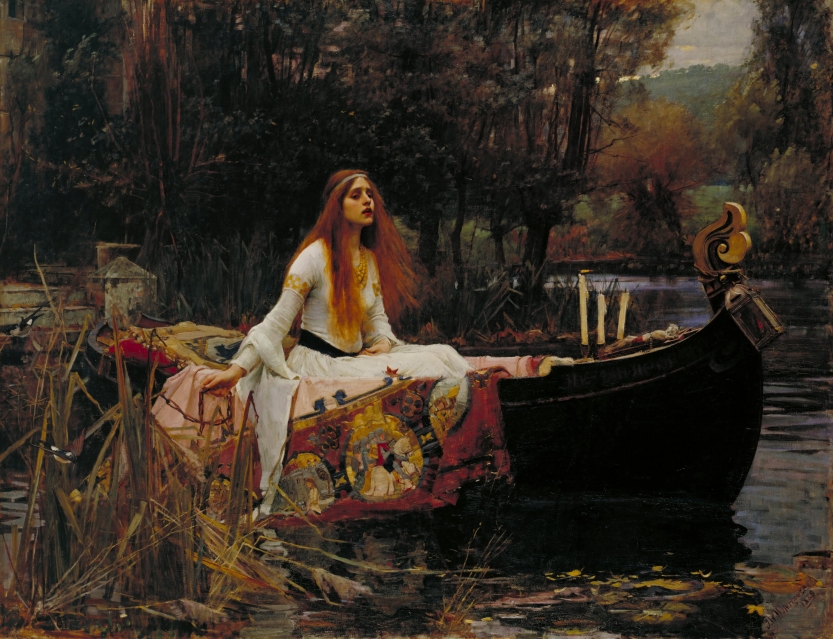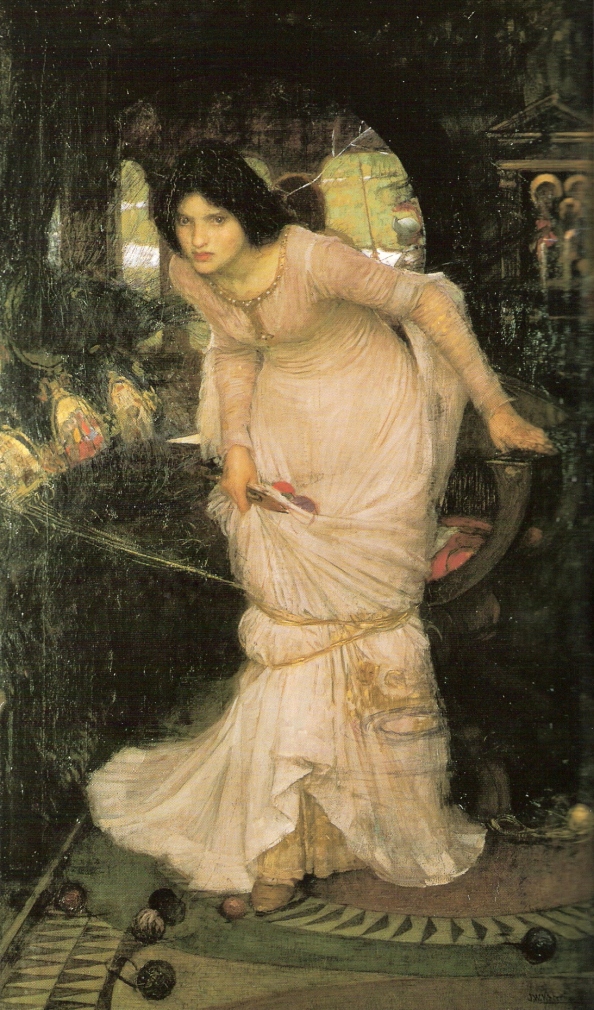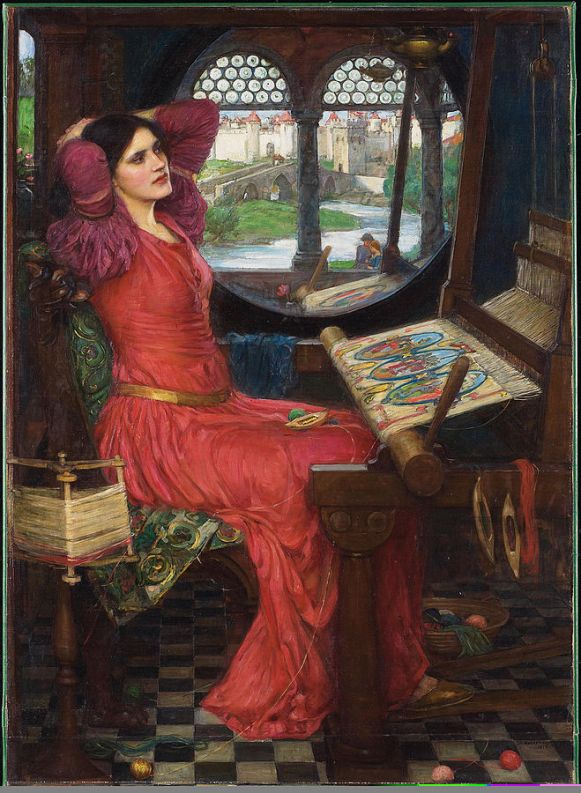The Lady of Shalott (1833/42) is a ballad based on medieval sources related to the legend of King Arthur composed by the Victorian poet Alfred, Lord Tennyson (1809–1892). Tennyson’s chief inspiration for the poem was the story of “Elaine of Astolat” as recounted in “La Damigella di Scalot,” tale 82 of Il Novellino, a thirteenth-century collection of Italian tales. Elaine was a maiden who deeply falls in love with the great swordsman Sir Lancelot – a Knight of the Round Table who is wooed by and marries another Elaine (of “Corbenic”); he also commits adultery with King Arthur’s wife, Queen Guinevere. Elaine of Astolaf is unsuccessful in approaching Lancelot and dies of grief when her love remains unrequited. She floats down the river on a barge to Camelot – King Arthur’s castle and court.
Tennyson’s second version of the poem is made up of nineteen stanzas and four parts (read it here.)
Part I – Stanzas 1 to 4
The Lady of Shalott is described as an inhabitant of a gray castle on an island of lush vegetation. A reaper working nearby hears her singing day and night. She is royally apparelled and surrounded by roses. Camelot can be reached from her dwelling by a shallop (vessel for shallow waters).
Part II – Stanzas 5 to 8
The lady is under an undisclosed curse. She is doomed to weave at her loom without looking directly at the world. Living without joy or fear, she just works and stares at a mirror – in which she sees reflections of village churls, market girls, damsels, the abbot, the shepherd, the page, a funeral procession and sometimes, a knight or two. Upon seeing a pair of newly-wed young lovers, she exhales, “I am half sick of shadows.”
Part III – Stanzas 9 to 13
One day, as bold Sir Lancelot makes his way past her residence on to Camelot, she is prompted to leave her loom and look up. Her web flies out and the mirror breaks. The curse is realised.
Part IV – Stanzas 14 to 19
Clothed in snowy white, she leaves her tower in stormy weather, finds a boat and writes her name upon it. Then, chanting mournfully, she floats down the river. By the time she reaches the garden wall of Camelot, she is a pale and cold corpse. Lancelot, who is present among the knights and dames examining her, thinks her a lovely face, full of God’s grace.
—-
Scholars have normally read the poem through two lenses – those of artistry and sexuality.
According to some, the Lady of Shalott’s distance from the society suggests Tennyson’s own reclusive existence. Perhaps the poet was trying to convey the message that artistic productivity can best thrive in solitude and is seriously jeopardised when an artist moves too close to the world.
On the sexual front, matters are more complicated and interpretations multiple and varying. First and foremost, the whole idea of an isolated and embowered maiden is a trope called hortus conclusus (literally, “enclosed garden”) going back to the Old Testament book of the Song of Songs (4:12). In medieval and Renaissance art, it was widely used to refer to Mary, the earthly mother of Christ – who, by some Christians, is believed to have been conceived immaculately (that is, without Original Sin) and in turn, conceived Jesus miraculously in a virginal state. [See an example of the Virgin Mary as hortus conclusus here.] Tennyson’s use of the trope is linked to Victorian conceptions of the feminine ideal – that of a reserved and industrious lady with elevated sanctity. Commentators have remarked that the Lady of Shalott’s escape from the tower is an instance of female empowerment – an act of defiance and a kind of coming to terms with one’s sexuality. Others see the narrative as a tale of temptation, with death as a timely event that preserves the lady’s innocence and keeps her from indulging in a potentially dangerous liaison. Then there are those who connect the lady’s passivity more with a mysterious and ambiguous “sleep” than with a final and irrevocable death (as in the fairy tales of Snow White and Sleeping Beauty) and simultaneously find suggestions of sustained virginity and sexual fulfillment therein.
—-
The poem was very popular among painters of the Pre-Raphaelite Brotherhood, a movement founded in England in 1848 (members were William Holman Hunt, John Everett Millais, Dante Gabriel Rossetti, William Michael Rossetti, James Collinson, Frederic George Stephens and Thomas Woolner). Later, John William Waterhouse (1849-1917), heavily influenced by the stylistic principles of the Brotherhood, created at least three paintings based on Tennyson’s text.



—-
![]()

I remember this poem and character thanks the unforgettable stories of Anne of Green Gables. ☺She was so in love with this poem and she even wanted to try it out how it feels like to be death and laid in the boat.
LikeLiked by 1 person
It is so sad and yet so beautiful!
LikeLiked by 1 person
I really enjoyed the experience of reading this poem along with your objective commentary. You helped to give the poem even more life for me. To experience the poem in a deeper way.
LikeLiked by 1 person
Great works of art are usually so complex and multi-layered. I love examining them through different perspectives. They should be accepted on their own terms and not prematurely tainted with any personal bias.
Another such brilliant and complicated work is Beckett’s Waiting for Godot, which I have examined here: https://onartandaesthetics.wordpress.com/2015/11/10/in-which-nothing-happens-twice/
LikeLiked by 1 person
Thank you very much. You are feeding me with so many wonderful experiences in art.
LikeLiked by 1 person
I love so much this poetry… one of my favorite in english!
LikeLiked by 1 person
Does anyone know where this painting may have been painted…? perhaps the River Thames? I believe John Atkins Grimshaw painted his on the River Thames….
Thank you, Julia
LikeLike